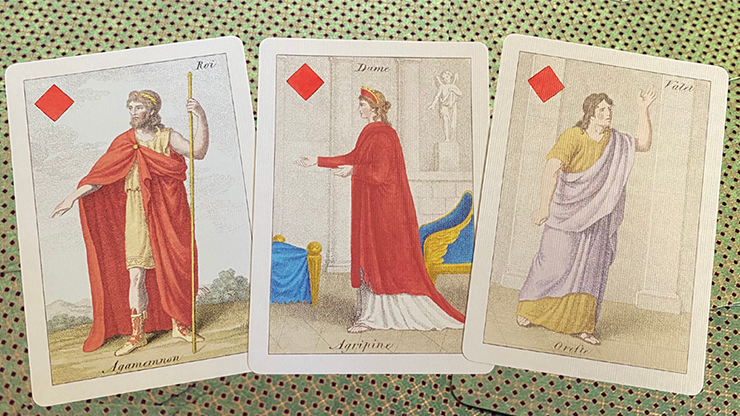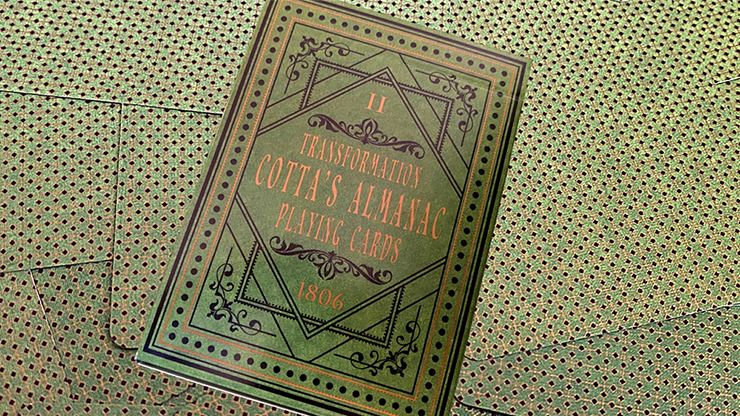1
/
of
6
Cotta's Almanac #2 Transformation Playing Cards
Cotta's Almanac #2 Transformation Playing Cards
Regular price
$ 11.99 USD
Regular price
Sale price
$ 11.99 USD
Unit price
/
per
Couldn't load pickup availability
Introducing a precisely digitally hand-recreated reproduction of the next Cotta's almanac deck full of history continuing a year after the previous blue one, which was the first published complete transformation playing card deck in the world!
The second transformation deck issued by Cotta is from 1806, following the remarkable success of the first almanac deck. This deck was also aimed to have well-known court cards, the interesting main characters and featured figures from classical antiquity, taken from sources such as Greek and Roman plays, as well as the Bible, which adds another historical value to its rarity.
The images on the court cards are the "Greek and Roman mythology" characters mostly centered around the Trojan war and inspired by Jean Racine's plays such as Iphigénie, Esther, Britannicus and the "Andromaque" ("Andromache") which was first seen on November 17th, 1667 before the court of Louis XIV in the Louvre in the private chambers of the Queen, Marie Thérèse, by the royal company of actors, called "Les Grands Comédiens", with Thérèse Du Parc in the title role. Andromaque, as the third of Racine's plays, written at the age of 27, established its author's reputation as one of the great playwrights in France.
The central figure of Andromaque is depicted as the Queen of Spades, she is the wife of the Trojan military hero Hector, daughter of Eetion, and sister to Podes and six other brothers; her name Andromache represents "courage" and has a meaning of "man fighter".
Cotta's second deck was, as well as the first deck, designed by Countess Mary Day von Jennison-Walworth (sometimes spelled with a single 'n'). Her maiden name was Beauclerk, and she was the wife of Count Francis Jenison Walworth (1764-1824). She was an illegitimate (twin) child who led a very colorful life and finally settled down somewhat after marrying Count Francis in 1797.
The second transformation deck issued by Cotta is from 1806, following the remarkable success of the first almanac deck. This deck was also aimed to have well-known court cards, the interesting main characters and featured figures from classical antiquity, taken from sources such as Greek and Roman plays, as well as the Bible, which adds another historical value to its rarity.
The images on the court cards are the "Greek and Roman mythology" characters mostly centered around the Trojan war and inspired by Jean Racine's plays such as Iphigénie, Esther, Britannicus and the "Andromaque" ("Andromache") which was first seen on November 17th, 1667 before the court of Louis XIV in the Louvre in the private chambers of the Queen, Marie Thérèse, by the royal company of actors, called "Les Grands Comédiens", with Thérèse Du Parc in the title role. Andromaque, as the third of Racine's plays, written at the age of 27, established its author's reputation as one of the great playwrights in France.
The central figure of Andromaque is depicted as the Queen of Spades, she is the wife of the Trojan military hero Hector, daughter of Eetion, and sister to Podes and six other brothers; her name Andromache represents "courage" and has a meaning of "man fighter".
Cotta's second deck was, as well as the first deck, designed by Countess Mary Day von Jennison-Walworth (sometimes spelled with a single 'n'). Her maiden name was Beauclerk, and she was the wife of Count Francis Jenison Walworth (1764-1824). She was an illegitimate (twin) child who led a very colorful life and finally settled down somewhat after marrying Count Francis in 1797.
- Printed by USPCC on classic stock
- Poker size
- Embossed finish
- 52 cards + 2 extra Jokers + 2 extra collectible cards
- Metallic ink on box & full bleed backs
- Custom tuck seal
- Puzzle image on all tuck spines of the series
- Digitally hand-recreated and designed by Azured Ox
- Produced by Will Roya
- 2021 release
Share












